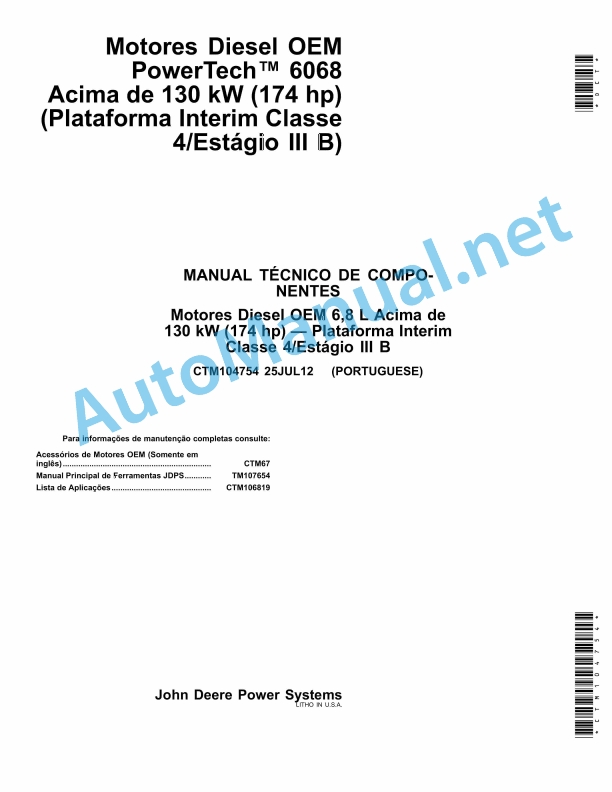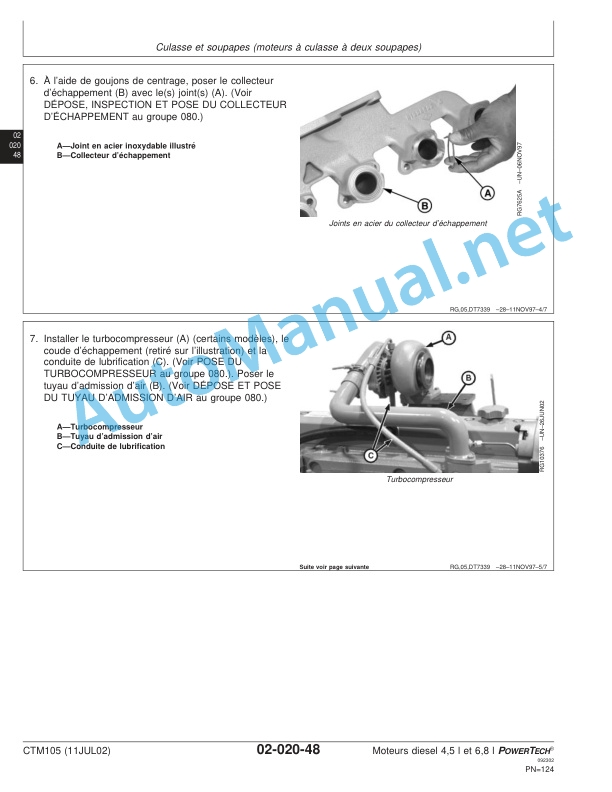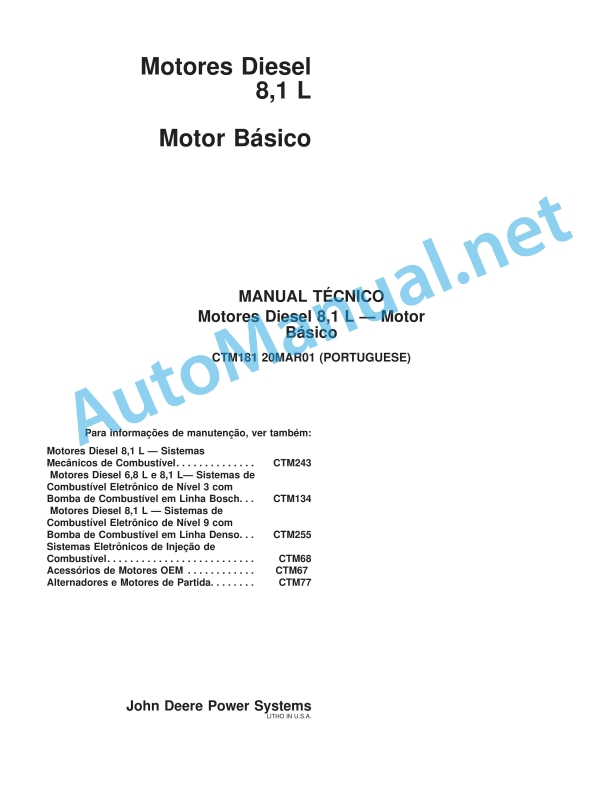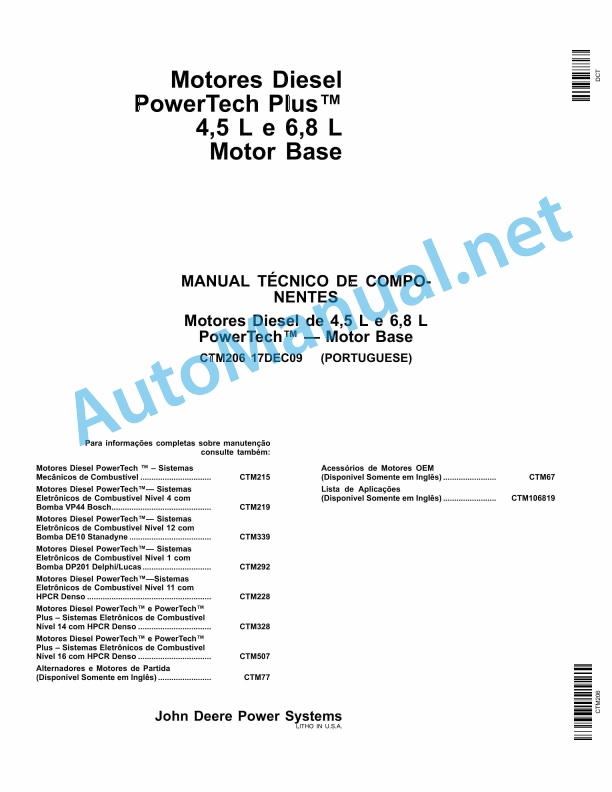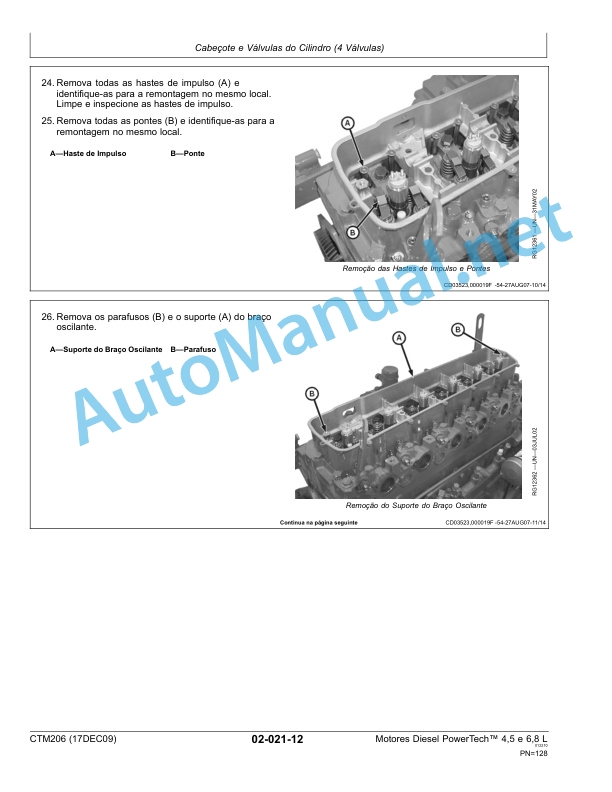Claas Volto 1320 T 1300 T (631) Tedders Operator Manual EN
$50.00
- Model: Volto 1320 T 1300 T (631) Tedders
- Type Of Manual: Operator Manual
- Language: EN
- Format: PDF(s)
- Size: 32.9 MB
File List:
00 0293 838 3.pdf
00 0296 954 3.pdf
00 0293 838 3.pdf:
VOLTO 1320 T
Table of contents
1 To this operator’s manual
1.1 Notes on the manual
1.1.1 General instructions
1.1.2 Validity of manual
1.1.3 Technical specifications
1.1.4 Symbols and notes
1.1.5 Using the manual
Directions
2 Safety
2.1 Safety rules
2.1.1 Particularly important
2.1.2 Qualification of drivers and maintenance personnel
2.1.3 Intended use
2.1.4 Reasonably foreseeable misuse
2.1.5 Safety and accident prevention regulations
2.1.6 First aid measures
2.1.7 Danger of injury from hydraulic liquid
2.2 Safety decals on the machine
2.2.1 Safety decals
2.2.2 Position of safety decals
3 Machine description
3.1 Overview and method of operation
3.1.1 Overview of VOLTO 1320 T
3.1.2 How the machine functions
3.2 Optional machine equipment
3.2.1 Optional machine equipment
3.2.2 Double wide-angle universal drive shaft with free-wheeling mechanism, 6-part
3.2.3 Universal drive shaft without free- wheeling mechanism, 6-part
3.2.4 Double wide-angle universal drive shaft with free-wheeling mechanism, 21-part
3.2.5 Slip yoke kit
3.2.6 Hydraulic connectors, 2-part
3.2.7 Lighting adapter for USA
3.2.8 Tine-loss protection ø 9.5 mm
3.2.9 Tine-loss protection ø 10.5 mm
3.2.10 Hydraulic swathing curtain
3.2.11 Spare wheel, 16×6.5-8
3.2.12 Spare wheel, 18.5×8.5-8
3.2.13 Anti-wrap guards for land wheels
3.2.14 Legal equipment for France
3.2.15 SMV triangle
3.3 Identification plates and vehicle identification number
3.3.1 Spare parts and technical questions
3.3.2 Position of identification plate
3.3.3 Position of identification number
3.3.4 Explanation of machine identification plate
3.4 Information on the machine
3.4.1 Decal
4 Operating and control elements
4.1 Sensor wheel
4.1.1 Crank
4.2 Hydraulic hose line
4.2.1 Shut-off tap
5 Technilpecifications
5.1 VOLTO 1320 T
5.1.1 Dimensions
5.1.2 Weights
5.1.3 Requirements for the tractor
5.1.4 Version
5.1.5 Tyre pressure
5.1.6 Noise level
5.1.7 Lubricants
6 Machine preparation
6.1 Shutting down and securing the machine
6.1.1 Switching off and securing the machine
6.2 Adapting the machine
6.2.1 Universal drive shaft – Checking the length
6.2.2 Universal drive shaft – Adapting the length
6.2.3 Fitting the universal drive shaft to the machine
6.2.4 Checking lock angle
6.2.5 Fitting the safety chain*
6.3 Hitching the machine
6.3.1 Connecting the hitch bracket
6.3.2 Installing the universal drive shaft
6.3.3 Fitting the safety chain*
6.3.4 Connecting the hydraulic hose
6.3.5 Plugging in the lighting cable
6.3.6 Stowing the wheel chocks
6.4 Unhitching the machine
6.4.1 Positioning the wheel chock at the wheel
6.4.2 Unplugging the lighting cable
6.4.3 Disconnecting the hydraulic hoses
6.4.4 Disconnecting the safety chain*
6.4.5 Removing the universal drive shaft
6.4.6 Unhitching headstock
6.5 Prepare road travel
6.5.1 Folding in the swathing curtain*
6.5.2 Folds the machine to transport position
6.5.3 Closing the shut-off tap
6.6 Preparing the working position
6.6.1 Opening the shut-off tap
6.6.2 Folding the machine to the working position
6.6.3 Folding out the swathing curtain*
6.7 Loading the machine
6.7.1 Lifting the machine
7 Operation
7.1 General safety precautions
7.1.1 Prior to operation
7.2 Driving on the road
7.2.1 Driving on public roads
7.3 Fieldwork settings
7.3.1 Adjusting the spreading angle
7.3.2 Adjusting the 16° spreading angle
7.3.3 Adjusting the 12° spreading angle
7.3.4 Adjusting the tines
7.3.5 Setting the working height
7.3.6 Adjusting the swathing curtain*
7.3.7 Wrap-around problems
Replacing the land wheel axles
Installing the anti-wrap guards*
7.4 Fieldwork
7.4.1 Fieldwork
4.2edding
7.4.3 Swath spreading
7.4.4 Turning
7.4.5 Swath turning
7.4.6 Night swathing
7.4.7 Tedding with the swathing curtain*
7.4.8 Engaging the PTO shaft
7.4.9 Adjusting the spreading pattern
7.4.10 Difficult conditions of use
7.4.11 Lifting in tight bends and when reversing
8 Faults and remedies
8.1 Causes and remedies
8.1.1 Hydraulic system faults
8.1.2 Machine faults
9 Maintenance
9.1 Maintenance Information
9.1.1 General maintenance warnings
9.1.2 Electrical system
9.1.3 Protective guards
9.1.4 Spare parts
9.1.5 Unbalance
9.1.6 Compressed air and water
9.1.7 Wheels
9.1.8 Burn prevention
9.1.9 Oils
9.1.10 Fire prevention and explosion prevention
9.1.11 Lines, tubes and hoses
9.2 Overview maintenance intervalls
9.2.1 Dealing with maintenance intervals
9.2.2 Before the harvest
9.2.3 After the first 10 operating hours
9.2.4 After the first 50 operating hours
9.2.5 Every 8 operating hours or daily
9.2.6 Every 20 operating hours
9.2.7 Every 50 operating hours
9.2.8 Every 500 operating hours or annually
9.2.9 Every 5 years
9.2.10 As needed
9.2.11 After the harvest
9.3 Maintenance operations in general
9.3.1 Clean machine
9.3.2 Preserve the machine
9.3.3 Checking the fittings
9.4 Gearbox
9.4.1 Check gearbox tightness
9.4.2 Main gearbox: Check the oil level
9.4.3 Main gearbox: Change the oil
9.4.4 Servicing the rotor gearbox
9.5 Clutches
9.5.1 Checking the overload clutch
9.6 Universal drive shaft
9.6.1 Maintaining drive shafts
9.6.2 Removing the power take-off shaft guard
9.6.3 Fitting the power take-off shaft guard
9.7 Chassis
9.7.1 Checking the tyre air pressure
9.7.2 Retightening the wheel nuts
9.7.3 Transport chassis: Changing a wheel
9.7.4 Adjusting the sensing wheels
9.7.5 Sensing wheels: Check the axles
9.7.6 Rotor chassis: Changing the wheel
9.7.7 Rotor chassis: Retightening the wheel nuts
9.7.8 Rotor: Retightening the bolts
9.8 Hydraulic system
9.8.1 Hydraulic system maintenance
9.8.2 Check the hydraulic hoses
9.8.3 Accumulator
9.8.4 Outside arms: Check the hydraulic cylinders
9.8.5 Longitudinal member: Check the hydraulic cylinders
9.8.6 Transport chassis: Check the hydraulic cylinders
9.8.7 Adjust the stroke limiting valves
9.8.8 Checking the block ball valve
9.9 Tine carrier
9.9.1 Checking the tines
9.10 Various components / Machine body
9.10.1 Outside arms: Check the braces
9.10.2 Arms: Check the supports
9.11 Lubrication chart
9.11.1 Grease all grease points every 8 operating hours
9.11.2 Grease all grease points every 20 operating hours
9.11.3 Grease all grease points every 50 operating hours
10 Placing out of operation and disposal
10.1 General Information
10.1.1 Putting out of operation and disposal
11 EC-declaration of conformity
11.1 VOLTO 1320 T
11.1.1 EC Declaration of Conformity
12 Technical terms and abbreviations
12.1 Terms and explanations
12.1.1 Technical words
12.1.2 Abbreviations
00 0296 954 3.pdf:
VOLTO 1300 T
Table of contents
1 Introduction
1.1 Notes on the manual
1.1.1 Validity of the manual
1.1.2 Information about this Operator’s Manual
1.1.3 Symbols and notes
1.1.4 Optional equipment
1.1.5 Qualified specialist workshop
1.1.6 Maintenance notes
1.1.7 Warranty notes
1.1.8 Spare parts and technical questions
1.2 Intended use
1.2.1 Intended use
1.2.2 Reasonably foreseeable misuse
2 Safety
2.1 Identifying warnings
2.1.1 Hazard signs
2.1.2 Signal word
2.2 Safety rules
2.2.1 Importance of Operator’s Manual
2.2.2 Observing safety decals and warnings
2.2.3 Requirements for all persons working with the machine
2.2.4 Children in danger
2.2.5 Hazard areas
2.2.6 Presence between tractor and machine
2.2.7 Persons riding on the machine
2.2.8 Hitching the tractor to the machine
2.2.9 Danger of injury from rotating shafts
2.2.10 Structural alterations
2.2.11 Optional equipment and spare parts
2.2.12 Control of the machine while it is running
2.2.13 Operation only after proper putting into operation
2.2.14 Technical condition
2.2.15 Danger from damage to the machine
2.2.16 Complying with technical limit values
2.2.17 Danger from continued running of machine parts
2.2.18 Keeping safety devices functional
2.2.19 Personal protective equipment
2.2.20 Wearing suitable clothing
2.2.21 Removing dirt and loose objects
2.2.22 Preparing the machine for road travel
2.2.23 Risks when driving on the road and in the field
2.2.24 Parking the machine safely
2.2.25 Unsupervised parking
2.2.26 Unsuitable operating utilities
2.2.27 Safe handling of operating and auxiliary utilities
2.2.28 Environmental protection and disposal
2.2.29 Fire prevention
2.2.30 Lethal electrocution from overhead lines
2.2.31 Pressurised fluids
2.2.32 Hot surfaces
2.2.33 Working on machine only after shutting it down
2.2.34 Maintenance work and repairs
2.2.35 Raised machine parts and loads
2.2.36 Danger from welding work
2.3 Safety decals on the machine
2.3.1 Structure of safety decals
2.3.2 Safety decals on the machine
3 Machine description
3.1 Overview and method of operation
3.1.1 Machine overview
3.1.2 Function of machine
3.2 Optional equipment
3.2.1 Double wide-angle universal drive shaft with free-wheeling mechanism, 6-part*
3.2.2 Universal drive shaft without free-wheeling mechanism, 6-part*
3.2.3 Double wide-angle universal drive shaft with free-wheeling mechanism, 21-part*
3.2.4 Slip yoke kit*
3.2.5 Hydraulic connectors, 2-part*
3.2.6 Lighting adapter for USA*
3.2.7 Tine loss protection ø 9.5 mm*
3.2.8 Tine loss protection ø 10.5 mm*
3.2.9 Hydraulic swathing curtain*
3.2. Spare wheel, 16×6.5-8*
3.2.11 Spare wheel, 18.5×8.5-8*
3.2.12 Anti-wrapping ptes*
3.2.13 Legal technical equipment for the European Union*
3.2.14 SMV triangle*
3.2.15 Headland hydraulic lift*
3.2.16 Side marker lights*
3.2.17 Stripper*
3.3 Identification plates and vehicle identification number
3.3.1 Machine identification plate
3.3.2 Machine identification plate
3.4 Information on the machine
3.4.1 Stickers on the machine
4 Operating and display elements
4.1 Controls
4.1.1 Hydraulic hose
4.1.2 Touch wheels
5 Technical specifications
5.1 VOLTO 1300 T
5.1.1 Dimensions
5.1.2 Weights
5.1.3 Requirements for the tractor
5.1.4 Electric system
5.1.5 Version
5.1.6 Tyre size
5.1.7 Tyre pressure
5.1.8 Sound pressure level
5.1.9 Lubricants
6 Machine preparation
6.1 Switching off and securing the machine
6.1.1 Switching off and securing the tractor and machine
6.1.2 Securing the raised machine
6.2 Tractor preparation
6.2.1 Checking the protective guard on the tractor PTO shaft
6.3 Adapting the machine
6.3.1 Checking the universal drive shaft length
Shortest working position of the universal drive shaft
Longest working position of the universal drive shaft
6.3.2 Adapting the universal drive shaft length
6.3.3 Fitting the universal drive shaft to the machine
6.4 Hitching the machine
6.4.1 Removing the safety lock*
6.4.2 Hitching up the hitch bracket
6.4.3 Installing the universal drive shaft
6.4.4 Fitting the safety chain*
6.4.5 Connecting the lighting cable
6.4.6 Connecting the hydraulic hose lines
6.4.7 Connecting the hydraulic hose line for the swathing curtain*
6.4.8 Connecting the hydraulic hose line for the headland hydraulic lift*
6.4.9 Stowing the wheel chocks
6.5 Unhitching the machine
6.5.1 Positioning the wheel chock at the wheel
6.5.2 Disconnecting the lighting cable
6.5.3 Disconnecting the hydraulic hoses
6.5.4 Disconnecting the hydraulic hose line for the swathing curtain*
6.5.5 Disconnecting the hydraulic hose line for the headland hydraulic lift*
6.5.6 Removing the universal drive shaft
6.5.7 Disconnecting the safety chain*
6.5.8 Unhitching headstock
6.5.9 Attaching the safety lock*
6.6 Prepare road travel
6.6.1 Folding in the hydraulic swathing curtain*
6.6.2 Folding the machine into the transport position
6.6.3 Closing the shut-off tap
6.6.4 Performing checks prior to road travel
6.7 Preparing the working position
6.7.1 Opening the shut-off tap
6.7.2 Folding the machine to the working position
6.7.3 Folding out the hydraulic swathing curtain*
6.8 Loading the machine
6.8.1 Lifting the machine
7 Operation
7.1 Driving on the road
7.1.1 Driving on public roads
7.2 Fieldwork settings
7.2.1 Adjusting the throw angle
7.2.2 Adjusting the 16° throw angle
7.2.3 Adjusting the 16° throw angle
7.2.4 Adjusting the 12° throw angle
7.2.5 Adjusting the throw angle
7.2.6 Adjusting the spreading pattern
7.2.7 Adjusting the tines
2.8 Setting the working height
7.2.9 Adjusting the hydraulic swathing curtain*
7.2.10 Removing wrap-around problems on the wheel axles
7.3 Fieldwork
7.3.1 To be observed during fieldwork
7.3.2 Tedding
7.3.3 Turning
7.3.4 Swath spreading
7.3.5 Night swaths
7.3.6 Swath tedding
7.3.7 Tedding with the swathing curtain*
7.3.8 Difficult operating conditions
7.3.9 Operating the headland hydraulic lift*
7.3.10 Lifting the machine for tight bends and when reversing
8 Faults and remedies
8.1 Overview of problems
8.1.1 Problems on the machine
8.2 Chassis
8.2.1 Replacing the wheel on the road running gear
8.2.2 Changing the wheel on the rotor running gear
8.2.3 Changing a gauge wheel
8.2.4 Adjusting the castor guide wheels
8.3 Hydraulic system
8.3.1 The process of folding the machine into its transport position is interrupted
8.3.2 The running gear is not being lowered when folding into the transport position
8.3.3 The machine is not being lowered when folding into the working position
8.3.4 Checking the headland hydraulic lift* valve
8.3.5 Rotor arms will not swing
8.4 Electric and electronic system
8.4.1 Lighting equipment defective
8.5 Assembled parts/Machine housing
8.5.1 Boom arm is not fully supported on the base
9 Maintenance
9.1 Maintenance interval overview
9.1.1 Before the harvest
9.1.2 After the first 10 operating hours
9.1.3 After the first 50 operating hours
9.1.4 Every 8 operating hours or daily
9.1.5 Every 20 operating hours
9.1.6 Every 50 operating hours
9.1.7 Every 500 operating hours or annually
9.1.8 Every five years
9.1.9 After the harvest
9.2 Gearbox
9.2.1 Checking the gearbox for leaks
9.2.2 Check the oil level in the main gearbox
9.2.3 Change the oil in the main gearbox
9.2.4 Servicing the rotor gearbox
9.3 Clutches
9.3.1 Checking the overload clutch
9.3.2 Cleaning the locking element clutch of the universal drive shaft
9.4 Universal drive shaft
9.4.1 Servicing the universal drive shafts
9.4.2 Removing the universal drive shaft guard
9.4.3 Installing the universal drive shaft guard
9.5 Chassis
9.5.1 Check the tyre pressure
9.5.2 Checking the wheel nuts on the road running gear
9.5.3 Checking the wheel nuts on the rotor running gear
9.5.4 Check the axle nuts on the touch wheels
9.6 Hydraulic system
9.6.1 Checking the hydraulic hoses
9.6.2 Checking the accumulator
9.6.3 Check the hydraulic cylinders for the outer arms
9.6.4 Check the hydraulic cylinders on the longitudinal beam
9.6.5 Check the hydraulic cylinders for the road running gear
9.7 Tine carrier
9.7.1 Checking the tines
9.8 Assembled parts/Machine housing
9.8.1 Removing crop residues
9.8.2 Clean the machine
9.8.3 Preserve the machine
9.8.4 Check the fittings
9.8.5 Check the screw connections on the frame
9.8.6 Check the braces of the outer arms
9.9 Lubrication plan
9.9.1 Greasing points to be greased every 8 operating hours
9.9.2 Lubricating the grease points every 20 operating hours
9.9.3 Lubricate lubrication points every 50 operating hours
10 Putting out of operation and disposal
10.1 General information
10.1.1 Removal from service and disposal
11 Declaration of Conformity
11.1 VOLTO 1300 T
11.1.1 EC declaration of conformity
11.1.2 UK declaration of conformity
12 Technical terms and abbreviations
12.1 Terms and explanations
12.1.1 Technical words
12.1.2 Abbreviations
John Deere Repair Technical Manual PDF
John Deere Repair Technical Manual PDF
John Deere Repair Technical Manual PDF
John Deere Repair Technical Manual PDF
John Deere Repair Technical Manual PDF
John Deere Repair Technical Manual PDF
John Deere Repair Technical Manual PDF
John Deere PowerTech M 10.5 L and 12.5 L Diesel Engines COMPONENT TECHNICAL MANUAL CTM100 10MAY11
John Deere Repair Technical Manual PDF
John Deere 16, 18, 20 and 24HP Onan Engines Component Technical Manual CTM2 (19APR90)
John Deere Repair Technical Manual PDF
John Deere Diesel Engines PowerTech 4.5L and 6.8L – Motor Base Technical Manual 07MAY08 Portuguese
John Deere Repair Technical Manual PDF




